Strange automotive history — From the 3-wheeled Tiger to the Interceptor
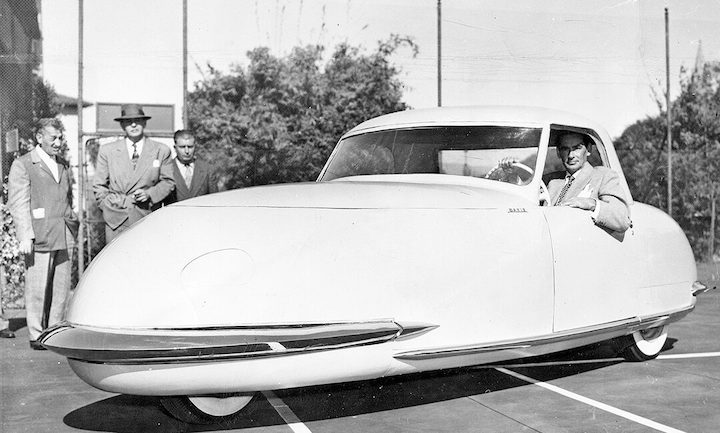
The three-wheeled Tiger Roadster
By Robert D. Cunningham
Courtesy of The Old Motor
(July 23, 2021) When Mrs. Joel Thorne ran off with a sailor in 1921, she left her 7-year-old son, Joel Wolfe Thorne Jr, in the hands of his father, the influential owner of Chase Manhattan Bank. Three years later, the banker was struck and killed by an automobile, and young Joel became the beneficiary of a trust fund worth an estimated $38 million (roughly $600 million in today’s money). With no need to work, the young man simply played, and he played to win.
In 1933, Thorne won the American Outboard Association High Point Trophy before turning his attention to the Indianapolis 500, where he participated in 1934 as a sponsor, as a car owner in 1936, and as an owner/driver in 1938. At the time Thorne designed his three-wheeled “Tiger” roadster with front-wheel drive and rear-wheel steering, he looked too young Frank Kurtis to build it. Kurtis rented space in Thorne’s machine shop, where he built midget racers.
Kurtis began the “Tiger” construction by removing the rear suspension and a section of the frame from a 1937 Ford and turned the assembly around so that the drive wheels were upfront; the Ford "60" V-8 engine was located in the rear. The single rear wheel turned the car, forklift style. Kurtis tested the motorized chassis up and down the street in front of Thorne’s shop, snapping the steering wheel hard from left to right and taking 90-degree corners. The tail end swung wide in turns, so Kurtis wisely reversed the chassis and placed the engine and steerable wheel upfront.
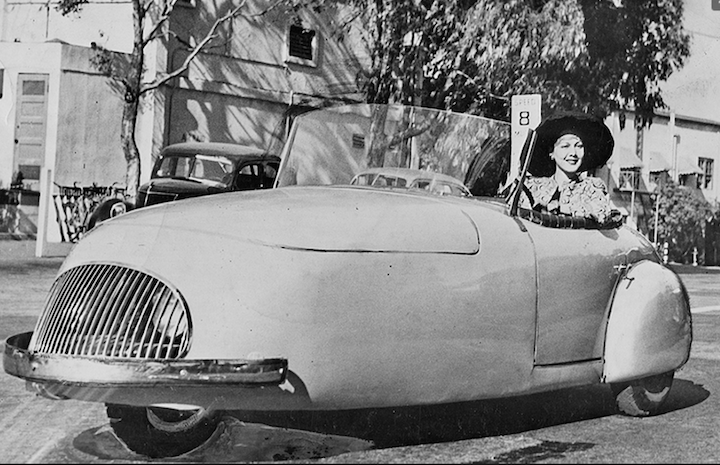
Frank Kurtis-built Thorne Tiger in 1942
Next, Kurtis hammered the “Tiger” sheet steel panels into an ultra-streamlined roadster body. Starting at the rear bumper, its rear deck sloped upward between pontoon fenders to a pair of small doors. The cowl was integrated with the front sheet metal, which tapered gently forward to form a rounded nose with headlamps recessed behind a removable slatted grille. The cockpit was richly upholstered in pleated leather and the bench seat folded forward to access a generous luggage space under the deck.
The brake pedal was eliminated; simply lifting one’s foot off the accelerator actuated the brake. And the steering wheel was designed to bend easily, just in case Thorne crashed, which he frequently did. Each time he had the battered “Tiger” remnants repaired by Kurtis. He even toyed with the idea of manufacturing a limited number of “Tigers” until a used car salesman named Davis fast-talked Thorne out of the “Tiger” and rights to the design.
Glenn Gordon “Gary” Davis had grown up on the car lots of Indiana, and he soon began to conjure promotional ideas that were designed to drum up interest in mass-producing the “Tiger.” According to an October 1945 article in the Los Angeles Times, Davis renamed the auto the “Californian” because the entire vehicle, including the buyers’ choice of four, six, or eight-cylinder aircraft engines, would be made in California.
Next, Davis soon established the California Motor Car Company in Los Angeles. He then engaged commercial, automotive illustrator Lee William “Bill” Jenks to refine Kurtis’s already sleek body design. Jenks proposed replacing the grille with a narrow cooling vent under the front bumper for hidden, inductive cooling. Jenks also recessed the headlights into the body and designed them to flip out when in use. Jenks’ remake of the Californian was so impressive that Gary Davis decided to give it a name more worthy of its remarkable design. He would call it the “Davis,” to be manufactured by the Davis Motorcar Company.
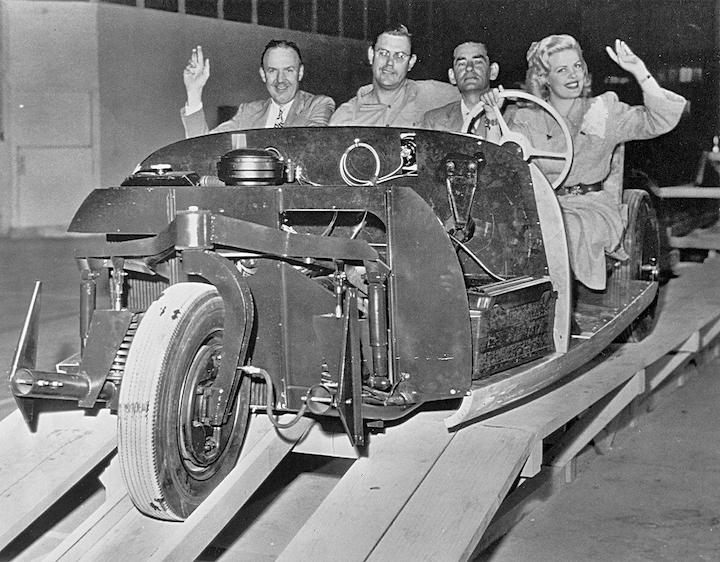
"Miss Van Nuys" Cleo Moore at wheel of the first Davis Chassis off the assembly line Oct. 16,1947
The first Davis car was completed on Oct. 15, 1947. Instead of an aircraft engine under the hood as promised, the vehicle carried a four-cylinder, 60-horsepower Hercules engine coupled to a Ford three-speed, stick-shift transmission, torque tube, and rear end. A second prototype, the Model D-2, was fitted with a removable hardtop and other minor body refinements.
The third car, which was the first to carry a Davis nameplate, was designated the Model 482 Four-Passenger “Divan,” in which all four passengers sat abreast on the single bench seat. The Divan’s chassis had been redesigned for mass production with a four-cylinder Continental engine, Borg-Warner transmission, and Spicer drive shaft. Plans included not only the four-passenger sedan but a seven-passenger sedan, station wagon, pickup delivery, and panel delivery.
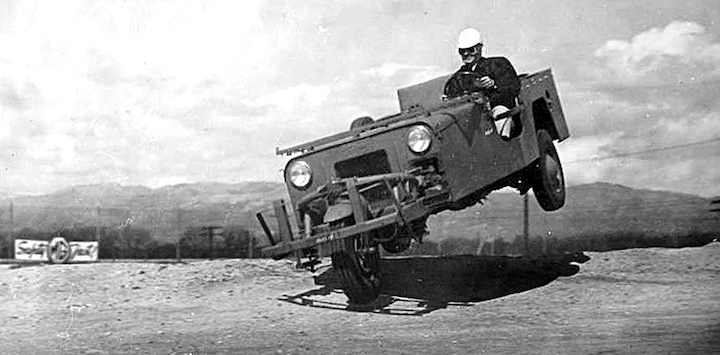
Davis' three-wheeled Jeep
When Davis demonstrated a few of his cars as part of President Harry S. Truman’s inaugural parade, he also offered to develop a three-wheeled jeep for military testing at the Aberdeen Proving Grounds in Maryland at his own expense. He had three Davis Model 494X Military Vehicles prepared within weeks, but the test results were disappointing. The three-wheel configuration, two-wheel-drive, low clearance, and long-wheelbase failed to meet the rigors of cross-country maneuvers.
Meanwhile, the Davis Motorcar Dealers Association asked the Los Angeles District Attorney to investigate Gary Davis and his business activities, claiming he had taken nearly two million dollars in franchise fees yet had provided virtually nothing in return. On top of that, only a total of 14 sedans and three military vehicles had been completed. Indeed, company records indicated Davis had used a portion of the fees to buy his home, finance motor trips to resorts, and purchase jewelry and furs for his wife.
Davis was charged with 28 counts of grand theft and convicted for selling dealership franchises on false promises and violating the California State Labor Code. He was subsequently sentenced to two years in prison. However, he soon became depressed and distraught after his wife stopped visiting him in prison, and Davis escaped to find out why. She urged him to turn himself in, after which he was confined for a time in solitary confinement.
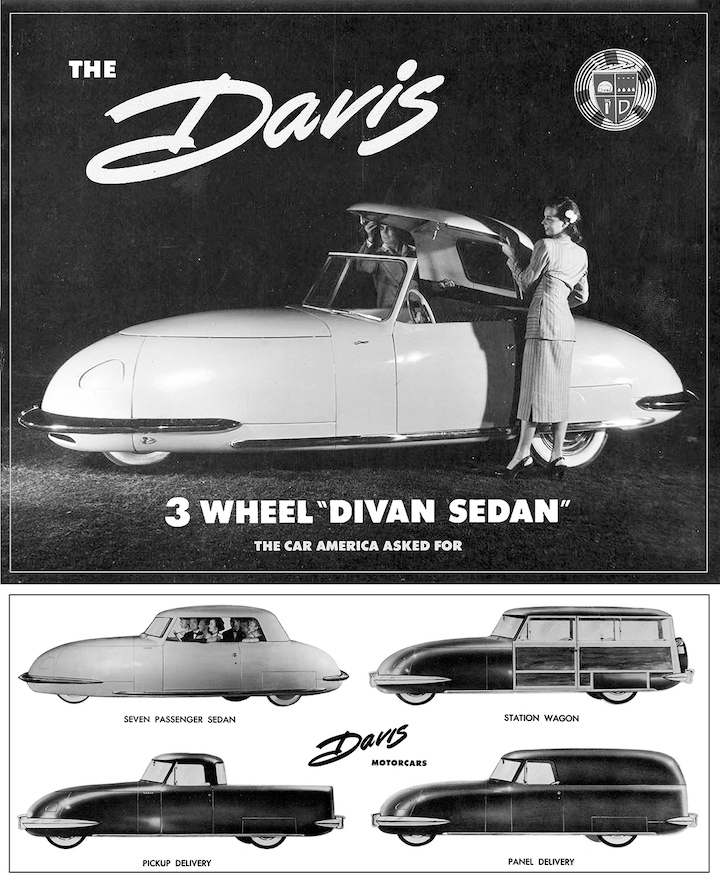
Gary Davis proposed a full ine of the-wheeled body styles
Davis then joined a partnership of former Davis franchise owners who pooled their resources to purchase one Davis car and enough tooling to resume production from behind bars. A prospectus for their new company, Delta Motor Car Corporation of Reno, Nevada, was distributed in July of 1953. Ironically, the Delta carried an English Morgan grille, which made it appear much like the original Thorne Tiger. Delta executives secured a deal with the Reliant Engineering Company Ltd., to produce fiberglass-bodied Deltas in Great Britain.
Following that, the single and only Delta was shipped to the Reliant automobile plant for an engineering examination. Engineers spent the next year modifying its suspension, however, by the time Reliant was ready to take formal steps toward Delta production, the Delta Motor Car Corporation had been dissolved, and English customs agents destroyed the Delta prototype for non-payment of import duties.
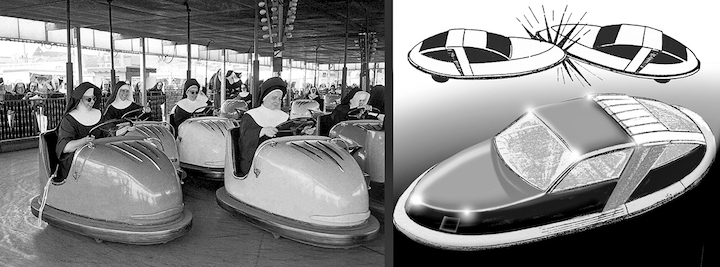
Gary Davis Dodgem bumper cars and the Interceptor Safety Car
Davis was released from prison in 1954 and quickly established Engineering Associates in Palm Springs, Calif. He consulted with the Dodgem Company of Lawrence, Mass., and redesigned their famous electric bumper cars. Predictably, his fiberglass-bodied upgrade looked very much like a miniature Davis Divan. Inspired by how well his new bumper car’s rounded shape and wrap-around bumper deflected severe collisions, Davis designed the full-sized, three-wheeled Interceptor safety car using bumper-car design principles.
The Interceptor also resembled a Davis Divan, but with chiseled, fastback styling. Up to eight occupants would be surrounded by air-filled modules lining the dash, doors, instrument console, and air-filled roll bar. The doors would slide forward for entry.
Unfortunately, court-imposed restrictions rendered Davis unable to build the Interceptor himself, so he searched for financial partners once again. But he had already constructed his last automobile. Gary Davis later died in 1973.
Robert D. (Bob) Cunningham is a commercial illustrator and author of several automotive history books.
